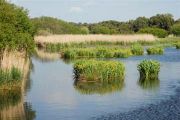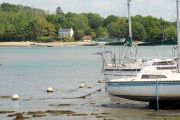 |
 |
Fouesnant – les Glénan, all the pleasures of the sea |
 |
A small town of the south Finistère, Fouesnant is the gateway to 17 km of coastline and the superb Glénan archipelago. A true paradise for holidaymakers who love sunbathing and water sports.
[ Practical ]
Getting there
- By road
560 km from Paris on autoroutes A10 and A81 till Rennes, then on N136, N165, D70 and D783 till Fouesnant.
- By train
TGV from Paris Montparnasse to Quimper. The journey takes 4 h 30.
Bus 42 from Quimper railway station to Fouesnant.
- By plane
Air France / Hop flights from Paris Orly to Quimper.
Bus to Quimper then Fouesnant or taxi to Fouesnant.
Lodging
- Hotels
Hôtel de la Pointe de Mousterlin
Hôtel de la Pointe du Cap Coz
Hôtel Best Western Cap Coz
Hôtel Belle-Vue, in cap Coz
- Residences
Résidence HMC Le Domaine des Glénan, in Beg Meil
Résidence Pierre & Vacances Cap Azur, in Cap Coz
Restaurants
L’Auberge du Bon Cidre, in Fouesnant
Le Roudou, in Fouesnant
Chez Alain, in Beg Meil
Le Filmore, in Beg Meil
Le Belle-Vue, in Cap Coz
La Pointe du Cap Coz, in Cap Coz
La Pointe de Mousterlin, in Mousterlin
Boat to les Glénan
Vedettes de l’Odet
Tel : 0298570058
www.vedettes-odet.com
Information
- Finistère Tourist Office
Tel : 0298762564
www.finisteretourisme.com
- Fouesnant-les Glénan Tourist Office
Tel : 0298511888
www.tourisme-fouesnant.fr
White sandy beaches and rocky coves bathed by turquoise waters. This kind of scenery reminds you of the South Seas but there is no need to go that far to enjoy it. You just have to go in Brittany, off the South coast of Finistere, in the Glenan archipelago. Nine main islands and a myriad of islets renowned for the whiteness of their sand indeed form something of a circle around a lagoon like patch of crystal clear waters.
 One inhabited island One inhabited island
When the sun is shining, it looks wonderfully exotic except there is neither coconut trees nor palm trees and the sea temperature is much colder. A lighthouse and a semaphore can be found on Penfret Island while Île Cigogne is easily recognizable by its fort, which was built in 1756 to keep English pirates out of the lagoon. Now a private property of French tycoon Bolloré, Loc’h Islands also boasts a landmark, a red brick chimney, only remain of a factory that burned kelp to produce soda ash.
Nowadays there is only one permanently inhabited island, Saint Nicolas, the only one linked to the mainland by regular boat services. It is also the only one where you can find lodging, restaurants as well as a few individual private houses built before the area was declared a nature reserve.
 White sandy beaches White sandy beaches
Nevertheless, a few fishermen are still allowed to catch lobsters and shrimps that you will of course find at the restaurants menus. It’s only a two kilometers long walk to go around the island and see pristine beaches as well as a unique flower that led to the creation of the nature reserve, the Glenan daffodil that grows nowhere else. In addition, you can walk from Saint-Nicolas to Bananec Island at low tide when a ribbon of sand appears between them.
In spite of the beauty of the site, the number of tourists remains limited except in July – August and the first Sunday of September when takes place a Pardon of the sea that gathers together fishermen from all over Finistère. The sea is then covered with boats. The island also has a dive centre because the beautiful seabed offers a great diversity of dive sites.
 Sailing and scuba diving Sailing and scuba diving
Les Glénan being the emerged summits of a small mountain range once linked to the mainland, the depth doesn’t exceed 5 m around the islands and 20 m between the archipelago and the coast. On the contrary, on the ocean side there is a deep seabed and there are breathtakingly steep drop-offs. But, talking about sports, Les Glénan is mainly known for its namesake sailing school that only offer week courses with slightly basic accommodation on two of the islands.
Administratively, the archipelago belongs to the small town of Fouesnant located on the mainland, not far from Quimper. Nestled around a nice Romanesque church, its historical centre is about 3 km inland, but the municipality’s territory encompasses 17 km of coastline where three hamlets developed as seaside resorts when beach vacations became popular. The oldest one is Beg Meil, originally a small fishing port from where leave now dives tours and the boats heading to the Glénan.

 Fouesnant / Mousterlin marshland © T.Joly Fouesnant / Mousterlin marshland © T.Joly
|
 Diverse flora and fauna Diverse flora and fauna
It became a tourist spot in the early 20th century, hence the numerous Belle Epoque villas scattered along the coastline and the namesake headlands where alternate tiny beaches, rocks and beautiful dunes. Westward, the coastline is a haven for those wishing to top up their tan in total tranquility tan thanks to two several kilometers long beaches separated by the Mousterlin rocky tip where are found a few lodging and restaurants as well as a single jetty. The first of these beaches stretches along a dyke built early in the 20th century when sluices were also put in place to drain the land. Most of the created polder is used as farmland, but there is still a marshland that is now a natural reserve, the Marais de Mousterlin that boasts exceptionally diverse flora and fauna.
 Cliffs and rocky coves Cliffs and rocky coves
The most western beach and its ribbon of dunes separate the ocean from an inlet known as La Mer Blanche, or the white sea, the name derived from the dazzling sands bordering its edges. At low tide, the seawater drains away almost entirely, leaving behind sandy flats that all manner of birds appreciate. On the other side of Beg Meil, toward the northeast, the coastline is totally different, wilder, rougher, consisting of a string of cliffs, rocky coves and small beaches following one after the other. This scenery is best discovered on foot and the Sentier des Douaniers hiking trail goes along the sea. After a few kilometers, it reaches the cap Coz beach and village where are found a large choice of accommodations and restaurants.

 Fouesnant / Anse de Penfoulic © T.Joly Fouesnant / Anse de Penfoulic © T.Joly
|
 Sea kayak tours Sea kayak tours
The beach ends along a strip of land that separates the ocean from a vast estuary with shallow waters, the Anse de Penfoulic. At low tide it turned into a mudflat where many birds like to come and the best way to get near of them is with a sea kayak. The Cap Coz water sports club can rent you one as well as sailboat and windsurfing board. Courses and excursions are also available. Between two bathing or sun tanning sessions, you can also explore the countryside by foot or by bike and discover chapels, calvaries, a tide mill and the beautiful Penfoulic manor. Seize this opportunity to stop at the local cider works said to produce one of France’s best ciders.
October 03, 2013
Thierry Joly 

|
|
 |

|
 |



